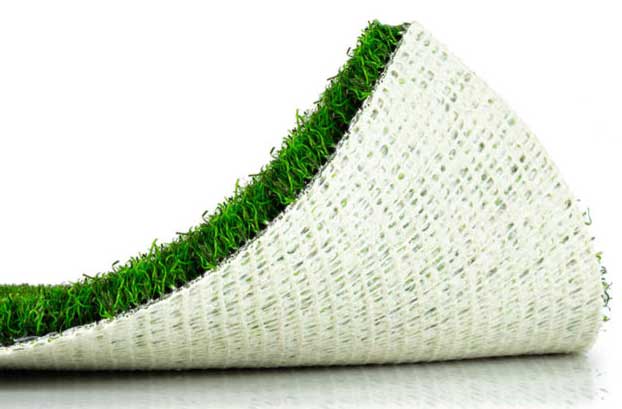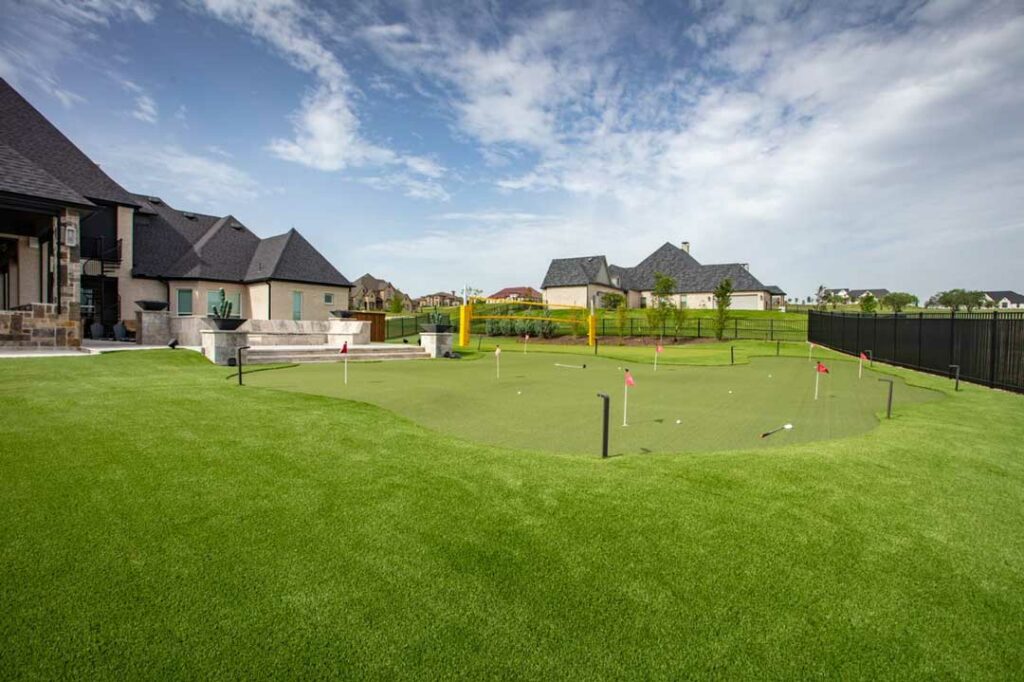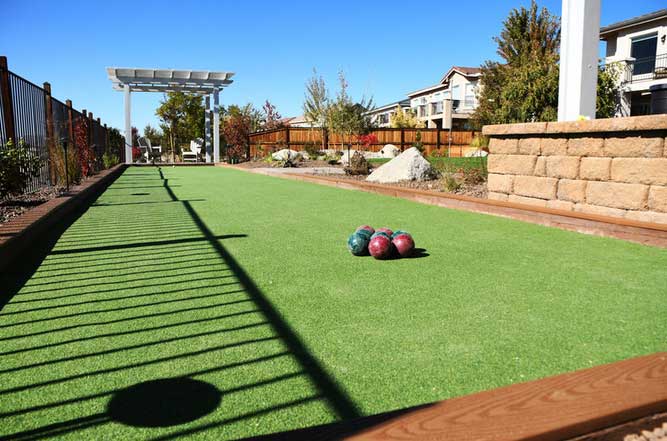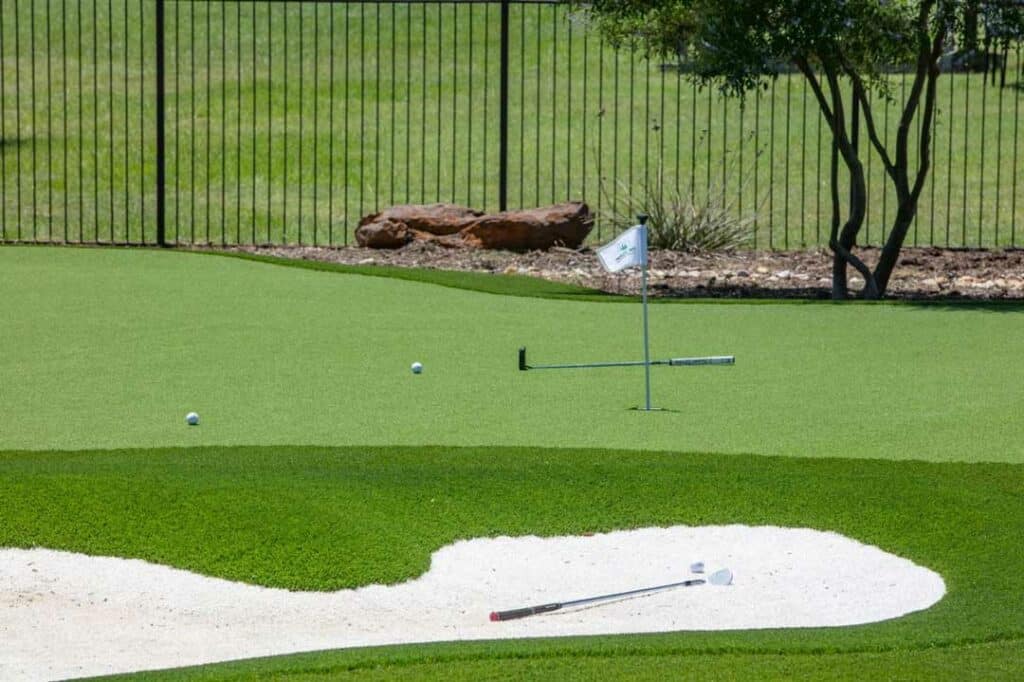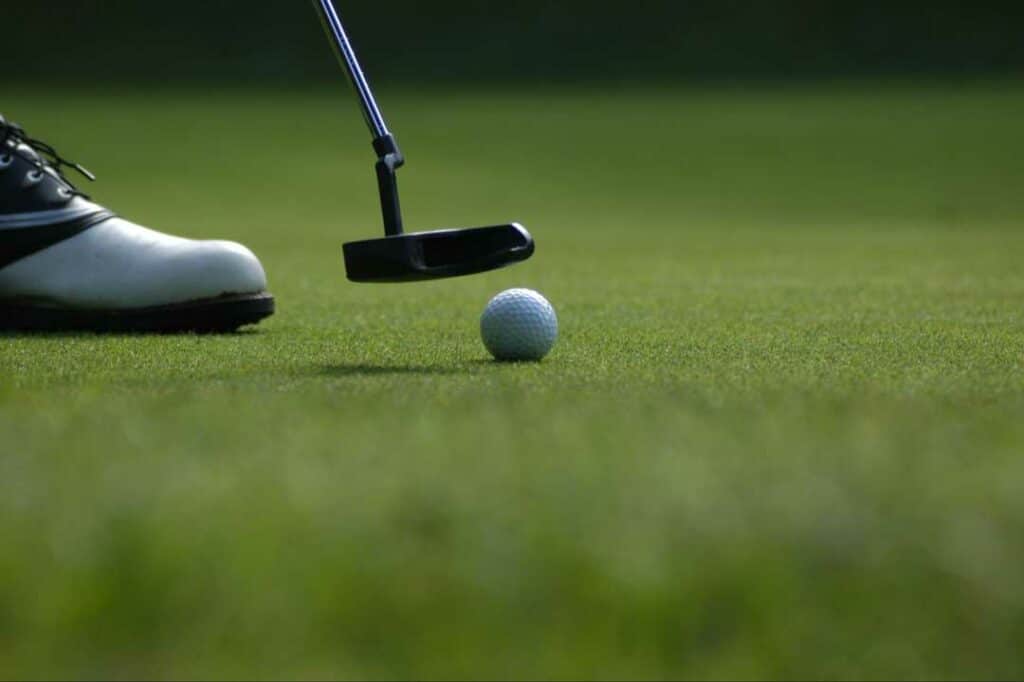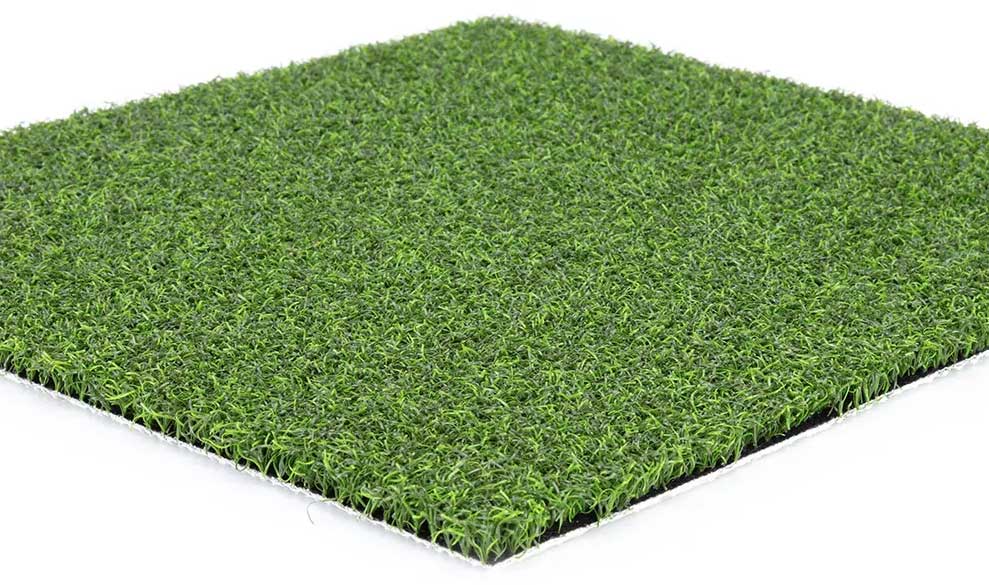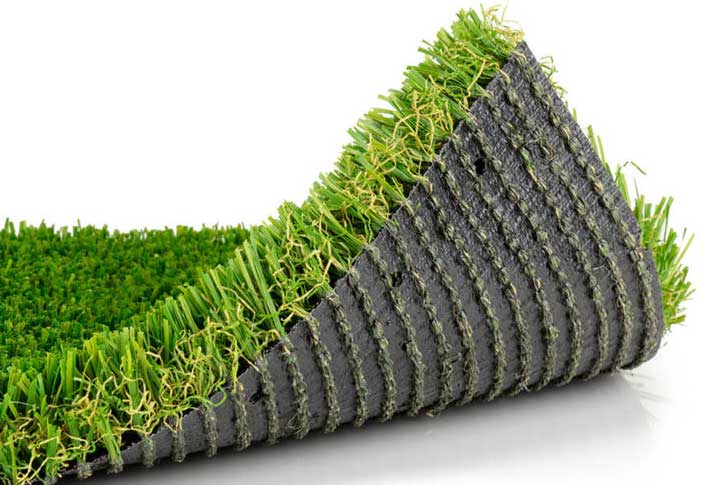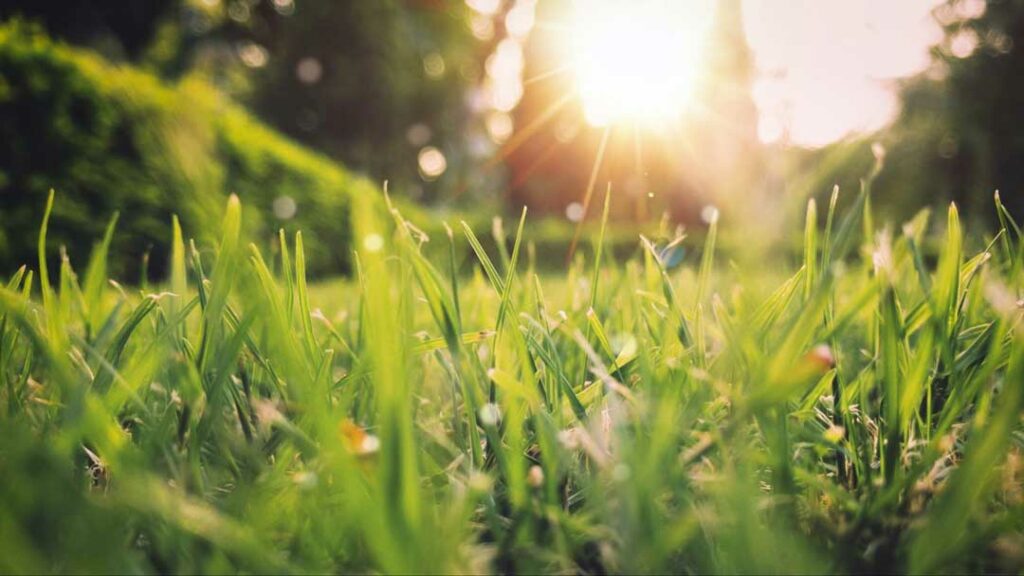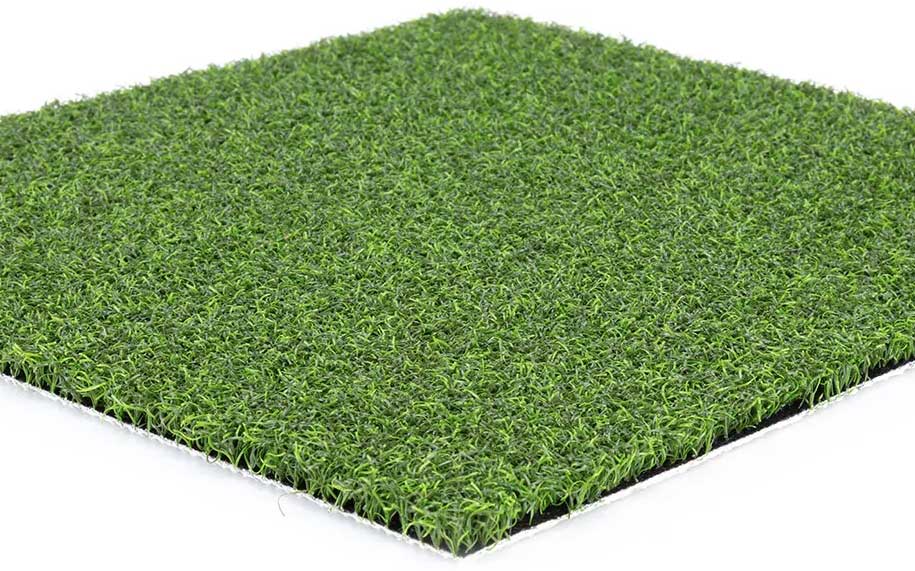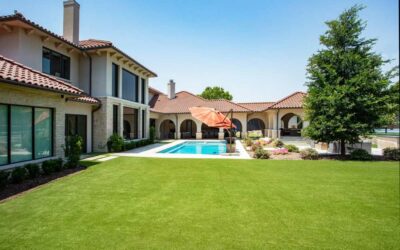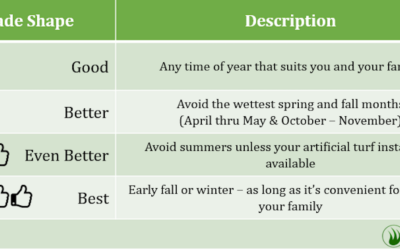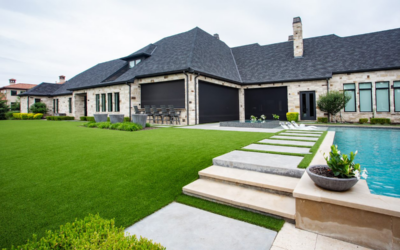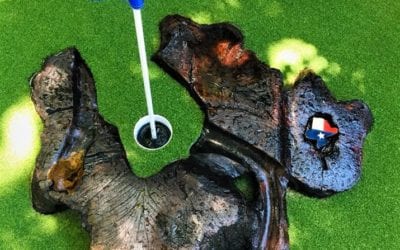You don’t need to be a golf pro to install a putting green in your backyard. Around one in ten artificial grass installations in Dallas-Fort Worth residential areas are putting greens or golf areas.
Maintaining a real grass golf area takes a frankly ridiculous amount of work. That’s where much of your expensive membership fee or $50-$150 green fee goes at your local golf club.
High-quality artificial grass specifically designed for putting greens has solved that problem. It’s ultra-low maintenance and remains verdant and immaculate, mimicking the true roll of a golf ball without you lifting a finger.
But not all synthetic turf is suitable for improving your short game. Different styles of grass suit different purposes from lawn/landscaping and pet turf to sports field turf.
The best artificial grass for putting greens is verdant and durable with a good face weight/density and short blades with compacted silica infill and UV protection.
Whether you’re a professional or casual player, if you’re in the Dallas-Fort Worth area, call us at 940-365-9165 to discuss your backyard putting green ideas.
Otherwise, keep on reading. Our guide helps you select the best synthetic putting green turf and introduces you to two of the best products on the market:
Best artificial putting green grass: quick summary
Why use artificial grass for your putting green?
Yes, the putting green you can see above is made from artificial grass! And you can achieve this natural look without virtually no time or effort!
A natural grass putting green takes time that most people — even avid golfers — don’t have. It also costs a lot of money to perfect a manicured appearance.
Even the simple act of mowing the grass on a putting green takes on new dimensions:
“Proper mowing includes daily mowing, daily changing of mowing patterns, mowing at the correct height, precise adjustment of mowers, daily cleaning and sharpening of mowers, training of mower operators and visual inspection of results. Mowing is the single most important practice in greens maintenance.”
Synthetic turf avoids this and allows even casual golfers to practice in their yards. The grass remains at the perfect height and stays beautifully green without any effort from the homeowner.
Golfers are switching to artificial grass for putting greens mainly for the following reasons:
- Minimal maintenance: synthetic putting turf requires a tiny fraction of the maintenance of a real grass putting green.
- Lower costs: over the 12–15-year life of artificial grass, your putting green will pay for itself several times over compared to real grass.
- Pristine appearance: your artificial putting green will look ready for match play all year round without any effort.
- Water conservation: synthetic grass greens use a tiny fraction of the water that a real grass green in the Dallas area will need.
- Lower chemical load (better for the environment): no fertilizers, pesticides, weedkillers or herbicides are needed.
- An artificial grass green may increase home value: well-installed backyard putting greens look impressive and can add curb appeal to your home.
- Controlled roll of the ball: with a professional installation, we’ll make sure that the type of roll on your green mimics a real green to help you improve your short game.
Putting green grass vs other grass
Different artificial grass types perform differently. What works for landscaped lawns, pets or kid’s play areas won’t work for a backyard putting green.
With numerous advancements in synthetic turf technology in recent years, turf is manufactured for many different purposes. Putting green grass is crafted in a special way for realistic appearance and performance.
Artificial putting green grass is designed to mimic the natural grass on golf courses. Its blades are trimmed along the top, helping to produce the same effect as mower-trimmed natural grass. Most professional golfers choose this type of grass as it allows them to practice at tournament level but recreational golfers will welcome it too.
Putting greens should usually include fringe grass, which is taller and straighter. Installing fringe around your green allows you to chip onto it, adding a further dimension to your short game practice sessions.
Many added extras can be included with a synthetic grass putting green to enhance practice, such as:
- Multiple holes
- Green contours or tiers
- Tee boxes
- Water hazards
- Bunkers and sand traps
- Lighting
With your putting green installation, you may be able to use existing slopes, berms, trees and ponds to make your putting/chipping area more interesting and challenging.
What is artificial putting green grass made from?
Artificial grass is made from yarn fibers that consist of one or more of the following three plastic materials:
- Polypropylene
- Polyethylene
- Nylon
Yarn fibers are woven into the backing and stick out the other side. They have a variety of shapes, thicknesses, lengths and colors but, for a putting green, a cross-section of turf usually looks like this:
Standard backyard artificial lawn grass fibers may be made of polypropylene as it is softer and cheaper for large areas. However, it may be less durable than the other materials.
Most golfers insist on the highest quality materials. Nylon is a popular choice in many sports installations because of its premium durability and longevity. It has a strong “blade memory” meaning that once it’s in place, it will retain its appearance and performance well.
This turf may cost a little more but provides outstanding durability even for high-traffic areas and is, therefore, often considered the best artificial grass for putting greens.
The choice between nylon and polypropylene won’t affect the roll of the ball or gameplay a great deal (that’s affected by other factors discussed below). Your choice may affect durability and longevity though.
Standard artificial grass for lawns includes a layer of thatch (curly, brownish dead grass) underneath the upright fibers to maintain a realistic appearance and “cushion” the grass. With putting greens, there may be no need for this as the grass needs to resemble a verdant, highly maintained real grass green with no dead grass. It’s down to user preferences as both thatched and un-thatched products are available.
All putting green turf installed by DFW Turf Solutions is made of nylon or polypropylene. This grass stands up well to the heat and sunlight in the Dallas area and is close to the natural appearance and feel of real grass.
What infill is used for artificial putting greens?
During installation, once the ground has been prepared and the artificial grass is in place, artificial grass needs infill.
The infill weighs down the grass fibers and prevents wrinkles and warping, neither of which are good looks for a putting green.
Sand, cork, walnut shells or crumb rubber may be used for infill on standard synthetic grass. We use a rounded silica sand infill on putting green surfaces so that the greens absorb some of the bounce of the ball (like soil does) and mimic a real grass putting green.
Low-infill turf requires less volume, allowing the ball to roll smoothly. For these reasons, it’s also perfect for croquet and bocce courts.
Choosing the right infill will help prevent mold and mildew from forming on your green, as well as improve the appearance and control ball roll speed and consistency.
We recommend antimicrobial infill if you have pets that may pee on your putting green when you’re not looking!
What determines the roll of a golf ball on artificial grass?
The surface of a putting green should be firm and smooth for the best roll of a golf ball. With a sand-filled polypropylene or nylon putting green, the roll of the ball can effectively be sped up or slowed down by controlling the amount of infill placed on the grass surface.
Sand-filled polypropylene or nylon putting greens are rolled to compact and secure the silica, leaving quite a hard and smooth surface.
Sand absorbs the energy of the golf ball, making it stop rolling. However, the less sand that is applied, the more blades will stick out and this will create friction to slow down the golf ball. The reverse is true too: to speed up the roll of the ball, you can add more silica to compact.
This is not a totally “linear” calculation. With infill, the smaller the grain size, the less it will interfere with the control and speed of the ball. Again, this can be set according to preferences.
Professional installation = happier golfers
Attempting a DIY installation with a backyard putting green is not a good idea. It takes specialist know-how and experience to ensure your putting green behaves how you want it to — and lasts the distance.
Nobody wants wrinkles, sun damage, stripes or rips.
An artificial grass installation is a long-term investment. Virtually all of the costs are upfront and you’re paid back in the long years of low maintenance. Skimping with installation is inadvisable with a lawn but downright foolhardy with a putting green. Too many things can go wrong.
The expertise of your service provider should start with advising you of the best options for your artificial turf. During the installation stage, their knowledge and experience are irreplaceable because you need to ensure:
- The ground is prepared correctly before the turf is rolled out
- The rolls of artificial grass are cut and joined correctly
- The right infill is used so that the blades stand upright
- The roll of the ball is true and at the right speed
- The bounce of the ball is true (from chipping areas)
- Drainage is optimized
What to look for when selecting artificial putting green grass
If you want to get the best artificial grass for a putting green, you need to know what to look for when choosing between the many varieties.
Ultimately, you want your green to stand up to the level of traffic you’ll put it through and keep on looking immaculate and performing well through the years, mimicking a real grass putting green as closely as possible.
To do that, it helps to know some of the synthetic turf terminology as you research. You’ll need to check the technical specs of the turf, including:
Color
Color variations allow more choice than ever for your putting green grass. If you want to closely match an area of real grass in your yard, that’s usually possible from the available options.
The best artificial grass for putting greens closely mimics real grass, which doesn’t usually grow with a uniform color (blades vary in color even within the same patch of grass).
If you’re in the Dallas-Fort Worth area, our team can help you match the color you need for your putting green.
Density
Density refers to the number of stitches per square yard of artificial grass. Generally speaking, denser grass means higher quality as the extra material can absorb potential wear and tear from putters and gold balls — creating a more durable surface.
Face weight
Face weight is the weight of the yarn (and thatch) excluding the backing. This is another good indication of artificial grass quality. More material means a greater ability to absorb traffic.
A good face weight for artificial grass for putting greens is 40 to 60 ounces per square foot or higher. Much lower than this and the grass may not have the look or feel of real grass and is unlikely to last.
Pile height
Pile height is the height of the fibers that make up the synthetic grass. The same term is used with carpets, so it may be familiar to you.
Golf greens are known for their carpet-like appearance and low blade height. Artificial grass for putting greens should have a pile height of between three-eighths and five-eighths of an inch, which looks like this:
This pile height would be too short for a backyard lawn. Usually, homeowners want a lush and springy lawn that feels great underfoot but golfers need to maintain a smooth roll of a golf ball.
Backing
The backing of synthetic grass is the surface on which the individual grass fibers are stitched and glued. There are two parts to backing on high-quality artificial turf:
- The primary backing, which is the netting material that the grass fibers are woven into.
- The secondary backing, which is the material that’s glued on the back and seals the turf together.
The backing weight is not included in the face weight but is included in the total weight of the artificial turf. Make sure you know what you’re reading on the labels if you buy it yourself.
Generally speaking, the higher the weight the better the durability (if all else is equal).
Drainage
Drainage is an important factor for any backyard area. Concerns over drainage with artificial grass can be alleviated with a professional installation using high-quality turf with decent backing.
The backing on standard turf usually has a series of perforations that allows rainwater, pet urine and other liquids to pass through to the ground below. This can disrupt the true roll of a golf ball and so some artificial putting green turf excludes this feature.
The backing looks like this…
…rather than this:
The lack of perforations is not usually a major issue for artificial putting greens in the Dallas-Fort Worth area. Because the square footage of the green is usually relatively small, drainage issues are rare.
However, the team at DFW Turf Solutions will assess the area fully before installing your artificial putting green and will identify any special drainage requirements.
UV protection
The Texan sunshine is strong and unrelenting for much of the year. Good quality artificial grass won’t fade or deteriorate even from the vicious heat as long as its properly UV-stabilized during the manufacturing process,
All grass installed by DFW Turf Solutions has UV protection and is designed for use in the Dallas-Fort Worth climate.
Professional vs recreational putting greens
Most recreational golfers won’t necessarily need the bunkers, sand traps or water features with their backyard putting greens — and in any case, might be restricted by space.
Recreational greens may have a limited fringe area (or none at all) and are designed mainly for pure green practice.
Professional backyard golf greens often include quite extensive chipping areas, which may require adjustments to the green to allow for how the golf balls bounce off it.
Simpler, recreational greens rarely need rolling because the turf fibers are usually crimped (textured). On the other hand, more professional-style greens may need daily rolling at first to achieve the desired roll speed — as well as frequent rolling afterward to help maintain performance.
Professional putting greens generally roll quicker than the average recreational green. The average ball speed will likely be 8-11 (stimp rating) on a recreational green and 10-13 on a professional one.
Best artificial putting green grass products
Two of the best artificial grass products for putting greens are available from DFW Turf Solutions. These are Tour Platinum and Tour Elite.
Let’s take a quick look at the properties of both:
Tour Platinum
Tour Platinum is backed by a 15-year warranty and is made of durable, texturized nylon. It has a short pile height and is designed for heavy use (regular putting and chipping). Tour Platinum is UV resistant with a natural rubber backing for a smooth installation.
Yarn type: Texturized nylon
Available colors: Viridian/Field
Face weight: Approx. 40 ounces
Total weight: 72 ounces
Primary Backing: 7 ounces
Pile height: 3/8 inches
Thatch color: N/A
Roll width: 15 feet
Infill: Silica (2-3 pounds per square foot)
Drainage rate: 30+ inches of rain per hour per square yard
Warranty: 15 years
Tour Elite
Tour Elite is made of texturized polypropylene and has a slightly taller pile height than Tour Platinum (plus it has thatch). It is UV resistant with a natural rubber backing for a smooth install and will withstand regular golfing practice over many years.
Yarn type: Texturized polypropylene
Available colors: Viridian/Field
Face weight: Approx. 52 ounces
Total weight: 84 ounces
Primary Backing: 7 ounces
Pile height: 5/8 inches
Thatch color: Brown/Green
Roll width: 15 feet
Infill: Silica infill (1-2 pounds per square foot)
Drainage rate: 30+ inches of rain per hour per square yard
Warranty: 15 years
FAQs
Get a customized putting green from the pros
A backyard putting green is the ultimate convenience for golf lovers everywhere. But most golfers often have specific preferences.
It’s not only the pile height, blade shape, roll, bounce and drainage that matter — many added extras might be required too, such as fringe, sand traps, water hazards, contours or other landscaping.
Unless you work with an installation company that can accommodate these preferences and customize your installation, you may be disappointed with the outcome.
At DFW Turf Solutions, we’ve been helping homeowners in the Dallas-Fort Worth area select the best artificial grass for putting greens since 2014. Our custom installations include design advice and plenty of backyard green ideas that you may not even have considered.To learn more and get a free quote on the synthetic turf products and services mentioned above, call 940-365-9165.





